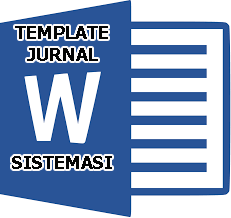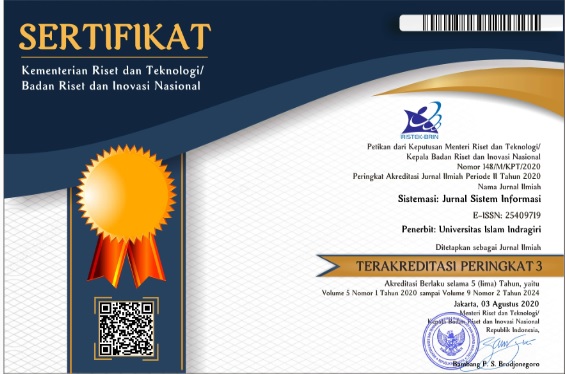Comparison of Machine Learning Methods (Linear Regression, Random Forest, and XGBoost) for Predicting Poverty in Central Java in 2024
Abstract
Keywords
Full Text:
PDFReferences
W. Agwil, D. Agustina, H. Fransiska, and N. Hidayati, “Klasifikasi Karakteristik Kemiskinan di Provinsi Bengkulu Tahun 2020 menggunakan Metode Pohon Klasifikasi Gabungan”, doi: 10.34123/jurnalasks.v14i2.348.
S. A. Latfalia and R. R. Marliana, “Klasifikasi Status Indeks Desa membangun Jawa Barat menggunakan Algoritma XGBoost,” Jurnal Riset Statistika, pp. 75–82, Dec. 2024, doi: 10.29313/jrs.v4i2.5011.
H. Hardianto, Y. N. Kunang, E. S. Negara, and T. Sutabri, “Model Data Mining dalam menganalisis Faktor-Faktor yang mempengaruhi Kemiskinan di Sumatera Selatan,” 2025, doi: 10.36040/jati.v9i2.12989.
D. N. Handayani and S. Qutub, “Penerapan Random Forest untuk Prediksi dan Analisis Kemiskinan,” RIGGS: Journal of Artificial Intelligence and Digital Business, Vol. 4, No. 2, pp. 405–412, May 2025, doi: 10.31004/riggs.v4i2.512.
D. A. Ubaid and M. I. F. Rachmad, “Klasifikasi Risiko Strok menggunakan Algoritma Random Forest dengan Teknik Knowledge Discovery in Database,” Journal Computer Science, Vol. 4, No. 1, 2025, [Online]. Available: https://www.kaggle.com/datasets/mahatiratushe, doi: 10.31294/5tbkg781
M. H. Mubarok and F. Septian “Prediksi GDP dengan RF dan XGBoost berdasarkan Aspek Sosial, Ekonomi, dan Lingkungan,” doi: 10.35957/mdp-sc.v4i1.11206.
G. Chairunisa, M. K. Najib, S. Nurdiati, S. F. Imni, W. Sanjaya, R. D. Andriani, H. Henriyansah, R. S. P. Putri, and D. Ekaputri, “Life Expectancy Prediction using Decision Tree, Random Forest, Gradient Boosting, and XGBoost Regressions,” Jurnal Sintak, Vol. 2, No. 2, 2024, doi: 10.62375/jsintak.v2i2.249
N. N. Sholihah and A. Hermawan, “Implementation of Random Forest and Smote Methods for Economic Status Classification in Cirebon City,” Jurnal Teknik Informatika (Jutif), Vol. 4, No. 6, pp. 1387–1397, Dec. 2023, doi: 10.52436/1.jutif.2023.4.6.1135.
R. P. P. Sinurat, “Analisis Faktor-Faktor Penyebab Kemiskinan sebagai Upaya Penanggulanagan Kemiskinan di Indonesia,” Jurnal Registratie, Vol. 5, No. 2, pp. 87–103, Dec. 2023, doi: 10.33701/jurnalregistratie.v5i2.3554.
L. Priseptian and W. P. Primandhana,“Analisis Faktor-Faktor yang mempengaruhi Kemiskinan,” Forum Ekonomi, Vol. 24, No. 1, pp. 45–53, 2022, [Online]. Available: http://journal.feb.unmul.ac.id/index.php/FORUMEKONOMI, doi: 10.33701/jurnalregistratie.v5i2.3554.
M. N. Faritz, “Pengaruh Pertumbuhan Ekonomi dan Rata-Rata Lama Sekolah terhadap Kemiskinan di Provinsi Jawa Tengah Ady Soejoto.”, doi: 10.26740/jupe.v8n1.p15-21
J. Halif, D. Wahiddin, I. Sanjaya, and S. Faisal, “Model Regresi Linear Berganda untuk Prediksi Tingkat Pengangguran di Provinsi Jawa Barat,” Jurnal Algoritma, Vol. 22, No. 1, pp. 324–335, May 2025, doi: 10.33364/algoritma/v.22-1.2312.
T. W. A. Putra, S. Solikhin, and M. Z. Abdillah, “Model Hybrid untuk Prediksi Jumlah Penduduk yang Hidup dalam Kemiskinan,” Jurnal Teknologi Informasi dan Ilmu Komputer, Vol. 10, No. 6, pp. 1253–1264, Dec. 2023, doi: 10.25126/jtiik.2023107484.
A. Heryati and T. S. Saputra, “Optimizing Socioeconomic Features for Poverty Prediction in South Sumatera,” TIERS Information Technology Journal, Vol. 6, No. 1, pp. 16–32, 2025, doi: 10.38043/tiers.v6i1.6244.
C. L. A. Navarro et al., “Risk of Bias in Studies on Prediction Models Developed using Supervised Machine Learning Techniques: Systematic Review,” Oct. 20, 2021, BMJ Publishing Group. doi: 10.1136/bmj.n2281.
Borito, B. Hendrik, “Infomatika Tinjauan Sistematis Metode Linear Regression, K-Nearest Neighbor dan Random Forest untuk Prediksi Tingkat Kemiskinan” Jurnal Informatika, Manajemen dan Komputer, Vol. 16, No. 2, 2024, doi: 10.36723/juri.v16i2.720
DOI: https://doi.org/10.32520/stmsi.v14i5.5494
Article Metrics
Abstract view : 1161 timesPDF - 191 times
Refbacks
- There are currently no refbacks.

This work is licensed under a Creative Commons Attribution-ShareAlike 4.0 International License.









